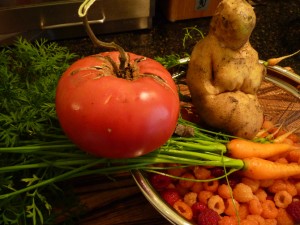Fall Waning Back to School Moon
Before the Vikings game on Sunday I made two chicken pot pies, whole pies filled with chicken, vegetables and a thickened vegetable broth made in the process. These are my second and third meat pies and I find I enjoy making them as much as I do soup. Something about baking a pie that has meat and vegetables intrigues me. This one had our leeks, potatoes, onions, carrots, garlic, parsley and thyme. My favorite vegetable from this garden is the leek. The subtle flavor and the delicate flesh of the leek both appeal to my palate.
Here are a few of the ingredients plus a tomato and raspberries from our garden. This potato looks similar to the woman of la mouthe in the MIA’s collection. At least to my eye. Fresh ingredients are key to Italian, Chinese and vegetarian cooking so a garden facilitates those cuisines, at least during the harvest system. Our best meals of the summer happen in September.
Fresh ingredients are key to Italian, Chinese and vegetarian cooking so a garden facilitates those cuisines, at least during the harvest system. Our best meals of the summer happen in September.
Visiting Westminster today brought up all kinds of memories. Don Meisel, former head pastor, came into the men’s room once during a Presbytery meeting. I had a report on top of the urinal, reading it. Don said, “My, you must get a lot of work done.” Presbyterian humor. Another surprising Don Meisel moment. There on the wall of a hallway was the exact same Granlund sculpture, the Tree of Life, that I bought Kate for her 50th birthday. Don had given it to the church in memory of his wife.
Jim Campbell’s name came up, too. Jim was a top exec of Northwest Bank and a leader on the Community Involvement Program’s board. I worked at CIP for 4+ years, starting as a janitor and week-end staff person during seminary and moving up to Director of Residential programs. Jim came to me at one point and asked if I would take on directing both the Residential programs and the Day Activity Centers. I thought about it and said no. That surprised him, I could tell. It surprised me a bit, too. I had no interest then or later in advancement, even though I did end up as an Associate Executive Presbyter.
Then, the chapel. What a peaceful space, a definite English feel to it wood, limestone, slate floor, a beautiful organ. Wilson Yates, then professor of society and religion at United Seminary, married Raeone and me in that chapel in 1979. Ed Berryman, the organist, refused to play the music we wanted. I don’t remember what it was. We had Handel’s Water Music. Ed liked it.
There were, too, many mornings of bible study with urban clergy in the now much renovated basement area. Bible study was always one of the fun parts because Presbyterian clergy pride themselves on their scholarly ability.
Well, off to bed. Gotta catch the Empire Builder at 7:30 am.
